

How to test your decision-making instincts. One of the most important questions facing leaders is when they should trust their gut instincts—an issue explored in a dialogue between Nobel laureate Daniel Kahneman and psychologist Gary Klein titled “Strategic decisions: When can you trust your gut?”
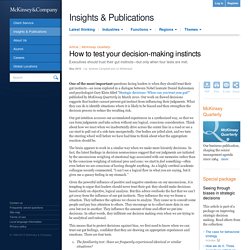
Published by McKinsey Quarterly in March 2010. Our work on flawed decisions suggests that leaders cannot prevent gut instinct from influencing their judgments. What they can do is identify situations where it is likely to be biased and then strengthen the decision process to reduce the resulting risk. Our gut intuition accesses our accumulated experiences in a synthesized way, so that we can form judgments and take action without any logical, conscious consideration.
Effective Decision Making. People often say that they find it hard to make decisions.
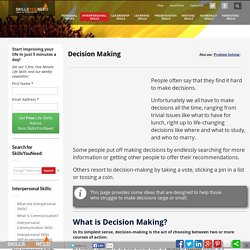
Unfortunately we all have to make decisions all the time, ranging from trivial issues like what to have for lunch, right up to life-changing decisions like where and what to study, and who to marry. Key Questions in Decision-Making. Decision Making: The #1 Secret Of Astronauts, Samurai, Navy SEALs, and Psychopaths. We all make a lot of bad decisions.
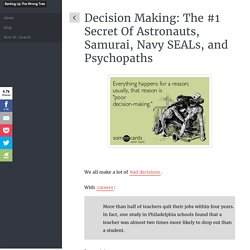
With careers: More than half of teachers quit their jobs within four years. How to Make Good Decisions ... Faster. Take a look at this paragraph: Cna yuo raed tihs?
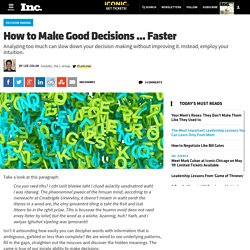
I cdn'uolt blveiee taht I cluod aulaclty uesdnatnrd waht I was rdanieg. The phaonemnel pweor of the hmuan mnid, aoccdrnig to a rsereeachr at Cmabrigde Uinervtisy, it dseno't mtaetr in waht oerdr the ltteres in a wrod are, the olny iproamtnt tihng is taht the frsit and lsat ltteers be in the rghit pclae. Tihs is bcuseae the huamn mnid deos not raed ervey lteter by istlef, but the wrod as a wlohe. Azanmig, huh? Isn't it astounding how easily you can decipher words with information that is ambiguous, garbled or less than complete?
The 80/20 Rule is pervasive in our world: 80% of traffic jams occur on 20% of roads.80% of beer is consumed by 20% of drinkers.80% of classroom participation comes from 20% of students.80% of profits come from 20% of customers. Applying the 80/20 Rule to your thinking can help you make smarter, faster, more intuitive decisions. Specifically, here's how you might apply the 80/20 Rule to your next decision. How to make smart, fast decisions (that you’ll still be happy with in 10 years!) How long does it take you to make a decision?
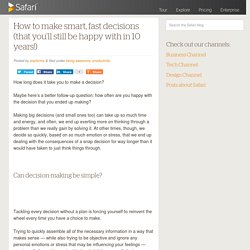
Maybe here’s a better follow-up question: how often are you happy with the decision that you ended up making? Making big decisions (and small ones too) can take up so much time and energy, and often, we end up exerting more on thinking through a problem than we really gain by solving it. At other times, though, we decide so quickly, based on so much emotion or stress, that we end up dealing with the consequences of a snap decision for way longer than it would have taken to just think things through.
The 40-70 Rule. Never wait for certainty in decision making. Interactive Tool: Decision-Making Guide. Kepner Tregoe decision making model. What is it?
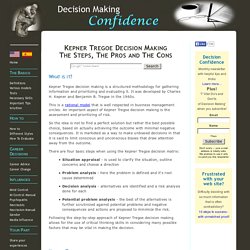
Kepner Tregoe decision making is a structured methodology for gathering information and prioritizing and evaluating it. It was developed by Charles H. Kepner and Benjamin B. Tregoe in the 1960s. Decision Making Process. Steps In Decision Making Process. OODA Loops - Decision-Making Skills. Understanding the Decision Cycle Observation is the first step. © iStockphoto/DivaNir4a Has it ever struck you just how many military terms have become everyday terms in business-speak?
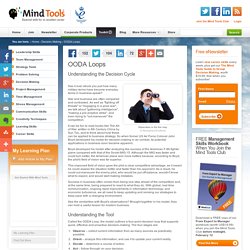
War and business are often compared and contrasted. As well as "fighting off threats" or "engaging in a price war", we talk about "gathering intelligence", "making a pre-emptive strike", and even trying to "out-maneuver" the competition. It can be fun to read books like The Art of War, written in 6th Century China by Sun Tzu, and to think about how these can be applied to business strategy.
Boyd developed his model after analyzing the success of the American F-86 fighter plane compared with that of the Soviet MIG-15. This improved field of vision gave the pilot a clear competitive advantage, as it meant he could assess the situation better and faster than his opponent. Success in business often comes from being one step ahead of the competition and, at the same time, being prepared to react to what they do. Decision Process Quality. Decision Making Process Questions. 3 Ways Elephants And Neuroscience Can Help You Make Better Decisions. Everything You Know About Neuroscience is Wrong Here’s a fancy brain picture for you: Research says that’s likely to make you think I know what I’m talking about — even if I don’t.
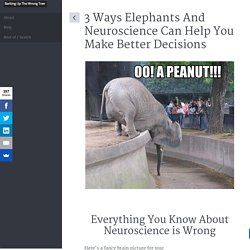
Via The Invisible Gorilla: How Our Intuitions Deceive Us: In one clever experiment, David McCabe and Alan Castel had subjects read one of two descriptions of a fictitious research study. The text was identical, but one description was accompanied by a typical three-dimensional brain image with activated areas drawn in color, while the other included only an ordinary bar graph of the same data. The brain is quite complex and poorly understood — even by experts. As Molly Crockett explains, most everything we read in the media about the brain is grossly oversimplified and often flat-out wrong. Oxytocin isn’t just the “love hormone.” Quantitative Pros and Cons - From MindTools.com. Weigh up Decisions With a Simple Approach © iStockphotostyf22 Weigh up the pros and cons of a decision.
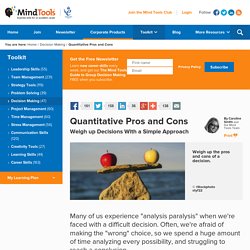
Many of us experience "analysis paralysis" when we're faced with a difficult decision. Often, we're afraid of making the "wrong" choice, so we spend a huge amount of time analyzing every possibility, and struggling to reach a conclusion. At other times, however, we are convinced that we already know what the best solution is, so we make decisions quickly and don't consider all the alternatives.
Decision Making Model. Like it Or Not, Emotions Will Drive the Decisions You Make Today. Your emotions will drive the decisions you make today, and your success may depend upon your ability to understand and interpret them. When an emotion is triggered in your brain, your nervous systems responds by creating feelings in your body (what many people refer to as a "gut feeling") and certain thoughts in your mind. A great deal of your decisions are informed by your emotional responses because that is what emotions are designed to do: to appraise and summarize an experience and inform your actions. But if an emotion is triggered, just how much should you pay attention to your visceral response and the thoughts it creates?
Emotions are not particularly sophisticated or precise, but their speed and utility make up for what they lack in sophistication and precision. Emotions, when they are not disordered, provide information about your circumstances in a simple, quick way that does not involve a lot of cognition (thinking about it). Emotions have tremendous action potential. Kepner-Tregoe Decision-Making Process. What Are Your Values? - Decision-Making Skills. Deciding What's Most Important in Life Find out how to identify your values, in this short video.
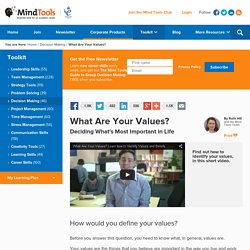
How would you define your values? Before you answer this question, you need to know what, in general, values are. Your values are the things that you believe are important in the way you live and work. They (should) determine your priorities, and, deep down, they're probably the measures you use to tell if your life is turning out the way you want it to. Online Tool: Weighted Decision Making Matrix. Decision Matrix Analysis. Making a Decision by Weighing Up Different Factors (Also known as Grid Analysis, Pugh Matrix Analysis, and Multi-Attribute Utility Theory) Learn how to use Decision Matrix Analysis to make better decisions. Imagine that your boss has put you in charge of taking on a new outsourced IT supplier. You've already identified several different suppliers, and you now need to decide which one to use. You could decide to go with the low-cost option.
How to Make a Decision Using a Quantitative Scoring System. Edit Article Edited by Rick Wiedeman, Ben Rubenstein, Krystle C., Jack Herrick and 21 others Life involves making a lot of decisions. Decision Maker. How to use The grid lets you enter options (things you'll choose between) in columns. Just click the "add option" button, and enter the name of each option. Decision Making Matrix example. Good Judgement = Good Decisions. Online Tool: Let Simon Decide. Six Keys To Making Good Decisions. On my first day in a class called "Decision Analysis" at Stanford, I was shocked when Prof. Ron Howard said that you couldn't judge a decision from the outcome. I walked up to him after class and said, "Professor, this is what I have read in spiritual texts - that we are only competent in the action, and the outcome is not in our hands.
Your principle is ancient. " Prof. Howard replied, "It may be, but these texts don't tell you how to apply this to financial decision-making, and we have worked out the details here. " Before going further, I must mention Prof. Online Tool: Business Idea Evaluator. Potential-Problem Analysis (PPA) The potential-problem analysis method (PPA) is designed to provide a challenging analysis of a developed idea or action in order to pre-empt any potential for going wrong (part of Kepner-Tregoe’s (1976 – qv),(see also Bullet Proofing and Negative Brainstorming). The method is closely related to some of the methods used in identifying potential faults in complex hardware systems, it has a ‘rational’ rather than ‘creative’ approach, but still provides and first-rate supply of creative triggers if approached in an imaginative spirit. A substantial amount of effort is required to carry out the analysis thoroughly and therefore the method is usually set aside for the more ultimate action plan (or perhaps the final handful of options).
Consequence Diagram. Taking risks if you can control the outcome! Olaf Swantee is the CEO of EE, responsible for running the UK’s leading communications company,... Olaf Swantee is the CEO of EE, responsible for running the UK’s leading communications company, which operates two of the most famous brands in the UK, T-Mobile and Orange. Prior to this, Olaf was a member of Orange France-Telecom’s executive board, heading the Group’s Europe division, which covered a mobile & fixed, €12.6B telecommunications business in Spain, Belgium, Switzerland, Eastern Europe, and the Dominican Republic. In addition, he ran the company’s Purchasing and Supply Chain function worldwide. Before joining Orange-France Telecom, Olaf had 17 years experience in the IT industry in Europe and the United States, latterly serving as Hewlett-Packard's EMEA SVP for enterprise sales and software.
The art of decision making and risk taking. Streamlining Decision-Making.